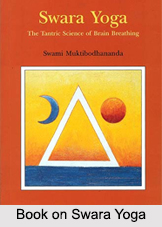 Swara Yoga is the science of realization of cosmic consciousness by the special awareness or observation and controlling or manipulating the flow of breathes through the nostrils. The word "Swara" is a Sanskrit word, which means sound or musical note, also means the continuous flow of air through one nostril. Tantric traditions like Surya Tantra, Ganpatya Tantra and Vaishnava Tantra also provides knowledge about Swara yoga.
Swara Yoga is the science of realization of cosmic consciousness by the special awareness or observation and controlling or manipulating the flow of breathes through the nostrils. The word "Swara" is a Sanskrit word, which means sound or musical note, also means the continuous flow of air through one nostril. Tantric traditions like Surya Tantra, Ganpatya Tantra and Vaishnava Tantra also provides knowledge about Swara yoga.
Swara Yoga is involves the systematic study of the breath flow through the nostrils or the Swara that is also related to the prevailing phases of the moon, time of the day and the direction. Swara Yoga is not like Pranayama or other breathing related yoga. In Swara yoga, the breath is associated with the activities or phases or positions of the sun, moon, planets, seasons, time of day and with the physical and mental states of the individual and these subtle reactions determine the mode of action accordingly. For example, in moon phases one can check the flow of breath through his/ her nostrils before getting out of the bed and floor should be touched first with the corresponding foot and the first step should be made with that foot. It is the simple practice that brings success in everything that happens in that particular day, the first foot to touch the ground will get the prevailing "successful" flow of energy from the cosmos.
Origin of Swara Yoga
 Swara yoga is a Tantric Science that originates from the Agama Shastras and from Shaiva Tantra, where Lord Shiva is the Guru and Shakti is the disciple. Swara Yoga is the ancient science that existed before the Vedic period, over 10,000 years ago. It was the secret science, only available for the selected few and was confined between kings and dedicated saints. The ancient saints and sages intuitively received the knowledge from the divine and kept it secret between them.
Swara yoga is a Tantric Science that originates from the Agama Shastras and from Shaiva Tantra, where Lord Shiva is the Guru and Shakti is the disciple. Swara Yoga is the ancient science that existed before the Vedic period, over 10,000 years ago. It was the secret science, only available for the selected few and was confined between kings and dedicated saints. The ancient saints and sages intuitively received the knowledge from the divine and kept it secret between them.
The ancient divine knowledge of Swara yoga was available only for Sadhakas as they had left behind the worldly and mundane affairs of life and had a spiritual attitude and a dedication and devotion of a disciple. The precious knowledge of Swara Yoga was thus kept pure and it didn"t go into wrong hands. The knowledge was used for yearly predictions and other prophecies.
Aims of Swara Yoga
Swara Yoga is related to breath, which is used to understand the governing forces of life, to understand the nature of the universe and effects of the elements on the mind and body. The Swara Yoga was meant for the people who have mental, physical and spiritual problems so that they could overcome their problem by the divine power of Swara Yoga. Also it was used to Grahastha, the householder, in day-to-day matter. The Swara Yoga was commonly used for general future prediction as well as for special cases such as going to war under a king, having a divine child, choosing an auspicious time, starting special jobs, journeys, wars, building, etc. It is also used for creating harmony in world affairs, predicting the time of death and to deal with planetary effects, astral forces and negative effects of planets on the zodiac signs and the constellations.
Benefits of Swara Yoga
Through the knowledge of Swara Yoga, one can get rid of all the negative influences of one"s destiny and can achieve heightened awareness. The Swara Yoga is also used to go beyond the limitation of the mind. The most important thing about Swara Yoga is to be aware about Swara or the dominant nostril in relation to the environment, one can manipulate the results of what one is about to do. Swara yoga method helps to go in the successful route by simply checking the nostrils before setting out of the house, noting the direction one wishes to go and then choosing the appropriate foot by which one will make his/ her first step. This ensures success and gives positive outcome of everything that follows thereafter.




















